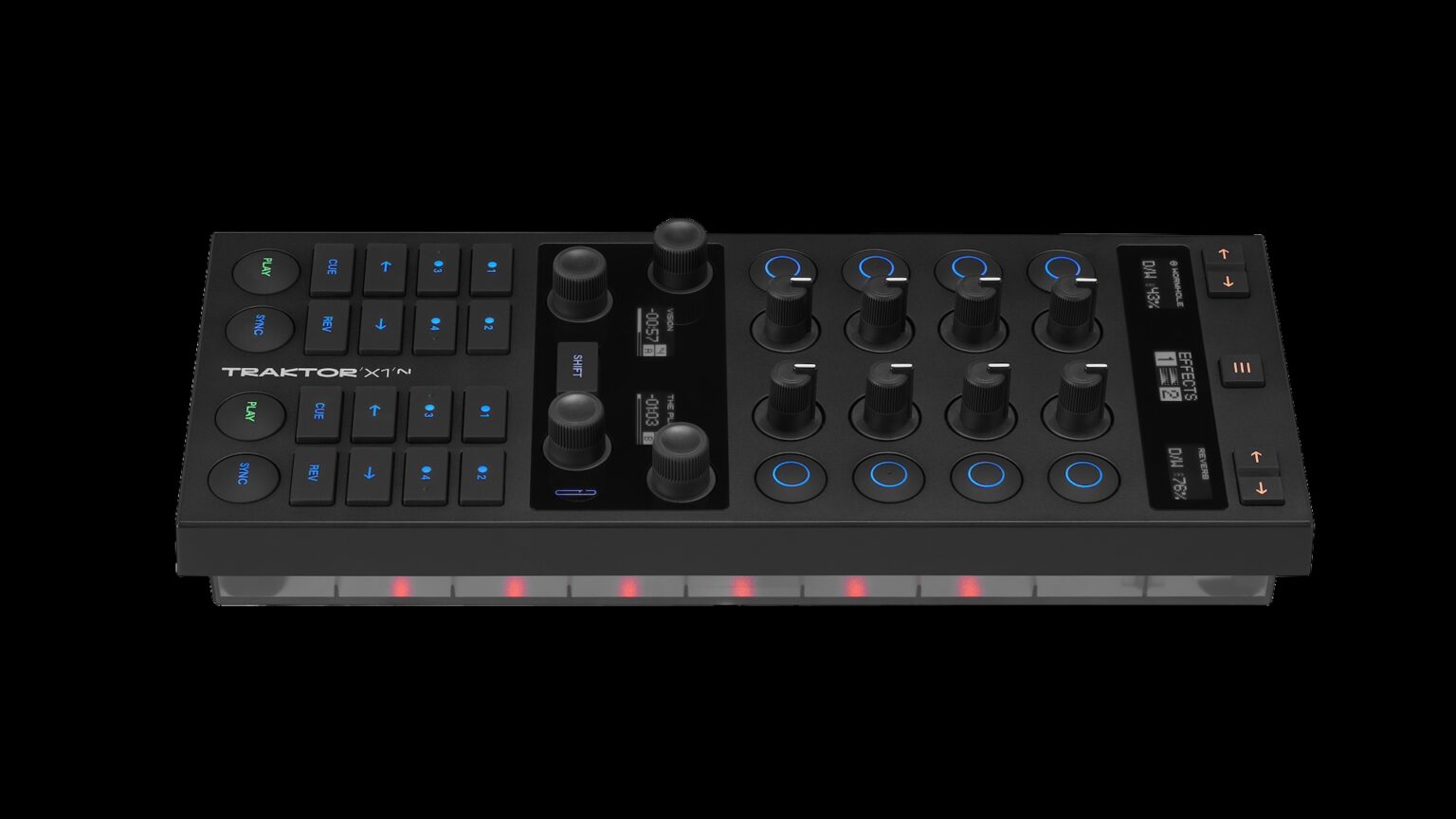“The unit’s focus is helping DJs navigate the many Traktor features that make for a compelling DJ performance, such looping and effects.”
If you’d have asked me just a year or two ago whether Traktor — the long-running DJ sub-brand from Germany’s Native Instruments (NI) — was still even a thing, I would have told you I wasn’t sure. I would have added that I was actively expecting an announcement to arrive at any point that the company had either divested itself of the software and hardware sold under the Traktor name, or that short of that, that NI would simply have chosen to pull the plug and all mention would vanish from its website.
I’d also have shared my deep love for Traktor. When I started DJing about two decades ago, I did so with Traktor. It was early days in the digital-DJ space, and my controller, as such, was a MIDI drum controller, the pads, sliders, and knobs of which I mapped within Traktor to do the stuff one needs to do in a DJ set. It worked, and Traktor software was the constant long after I switched to more sophisticated, more purpose-built solutions.
In the years since, and with all due respect to certain other DJ software application that I also know, use, and love, I’ve maintained the belief that Traktor provides the most polished and most intuitive user experience and interface in the market (although that’s more debatable now than at any point in the past). So, imagine my surprise when I received the press announcement that against all imagined odds, Native Instruments was releasing a new (or at least retooled) Traktor controller; that there was life in the Traktor product team in Berlin after all.
A New Take on a Unique Controller
Native Instruments has produced its share of “fits-the-standard-template” DJ controllers in the past, but they’ve also consistently produced their share of controllers that break the mold, and the Traktor X1 is such a controller. The newly released MK3 version of the X1 brings new capabilities to the X1 platform that was launched in 2010, but hasn’t seen a major update in over a decade.
Like its predecessors, the unit is smallish; about 5-inches wide, nearly 13-inches front-to-back, and a bit over 2-inches tall, weighing in at roughly a pound and a half. In other words, it’s compact and portable. It’s USB-powered, but the included AC power supply enables use of the unit’s rear USB ports to connect other devices, acting as a small USB hub that keeps your set-up a bit tidier.
Make no mistake… the X1 is not a standalone controller as such, as it offers no audio I/O as full-size controllers do, nor will you see a crossfader or other sliders, and there is, of course, no room for jog wheels. Its focus is helping DJs navigate the many Traktor features that make for a compelling DJ performance, such looping and effects, while small OLED displays (five of them are arranged on the unit) and color lighting on the controls and the unit itself provide visual feedback, plus direct access to things like track time remaining, BPM, loop sizes, and so forth.
The Specifics
To start, the X1 MK3 allows you to easily browse your music collection and load tracks to a deck in Traktor without resorting to a mouse or trackpad on your laptop. The unit’s four rotary encoders, center shift button, and adjacent OLED displays make it intuitive and display appropriate contextual information. While the capability is effective, I often find myself preferring doing track selection on the computer, as I’m often wanting to sort columns, scroll, or proactively search my vast library. That said, it’s a useful fallback method, especially for DJs who might preplan and organize tracks for a specific set.
Users new to the X1 may find that the transport controls require some getting used to, and without a crossfader or traditional level sliders, the X1 MK3 isn’t going to appeal to every DJ or performance style. I don’t personally find that to be too limiting, in no small part because I don’t use crossfaders, and old-school rotary mixers aren’t a foreign concept either. But with no jog wheels, syncing tracks with the unit means depending on Traktor’s own beat identification logic, and making sure that when tracks are first brought in, the timing is correct, and downbeats are aligned properly — and everything corrected as needed — all ahead of time.
But it’s also here where the X1 MK3 shines; the compact form factor and its design concept seem tailor-made to leverage cue points and looping (more on that in a moment), allowing DJs to shred and remix tracks on-the-fly with abandon.
Mixing mode with the unit maps its eight primary rotary encoders — four on each side — in the logical positions for control of track gain, plus three-band EQ, with the adjacent buttons performing cut operations at the corresponding frequency range.
Effecting the output is another of the X1 MK3’s claims to fame. Setting the unit for this mode, it puts control of over 12 effects in four banks at your fingertips. The rotary encoders in this mode are used for dry/wet control, plus controls for each of the three effects within a bank.
Like many companies in the music space, Native Instruments has brought some subscription-based features to the Traktor platform in the form of the Pattern Player, one of the benefits of a Traktor Pro Plus plan. I’m very much on-the-record as resenting subscription plans in the music space, but I can grudgingly admit that it may well bring some benefits to DJs who opt in, and the X1 MK3 takes advantage of it by providing Pattern Player support. In short, it allows you to bring in outside beats to set a foundation for your mix, while manipulating playing tracks.
So, how does Native Instruments pack all of this into a unit with just 34 buttons and 12 knobs? In a word, carefully — or perhaps, creatively. Two of the buttons are essentially modifiers; one changes the mode, and the other is a shift button. As you might guess, with all the control options and different modes, there’s a lot of overlap with functionality-to-controls mapping, and you’ll doubtlessly find that using an X1 MK3 requires practice in order to understand the modes, how the unlabeled controls are mapped in software, and to ensure that you’re in the right mode before moving a control.
This isn’t a criticism, it’s just a statement of fact that compact controllers with limited physical controls are not entirely unlike learning to use a saxophone. OK, maybe it’s not that bad, but regardless, your fingers are going to get a workout, and you’ll need to take the time to develop some muscle memory. But given the functions of the controller and how it complements other gear, it may mean that you limit its focus to certain areas, versus trying to force it to be and do everything.
Configurations Abound
Speaking of, how an X1 MK3 might fit into your set-up depends on the gear you have, and how you like to work. Native Instruments’ website provides some suggestions for how you might incorporate the X1, and they vary from using a pair of them with a mixer, to using one with a mixer and a pair of decks, to pairing one with Native’s Z1 to give you the audio interface capabilities that the X1 itself doesn’t offer.
In Conclusion
It’s refreshing to see Native Instruments actively investing in the Traktor platform, and new DJ-related hardware from the company is welcome news. The X1 MK3 is a unique, interesting, and powerful controller that will put key Traktor functionality at your fingertips, and provides an array of benefits — even if you do still need a separate audio-interface-capable unit for serious use. With practice, it promises to make your sets more compelling, more interesting, and easier to perform, leveraging Traktor’s powerful ability to not just mix tracks, but to chop them up, remix on-the-fly, and incorporate other material (such as with the Pattern Player). And with a street price of just under $300, and with the included Traktor Pro software license, it packs a lot of capability into a small, portable, and affordable unit.


